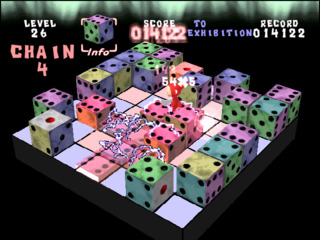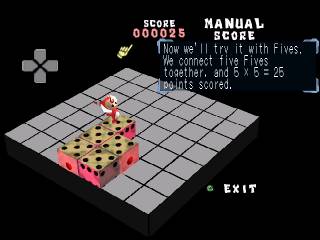Overview

Devil Dice, known in Japan as XI (pronounced "sái") and as XI [sái], is a 3D action-puzzle game developed by Shift and published by Sony Computer Entertainment (THQ in North America) for the Sony PlayStation in Japan on June 18, 1998, in North America on September 24, 1998, and in Europe on January 15, 1999.
In Devil Dice, players control a little devil (known as Aqui) as they run around the playfield, moving large six-sided playing dice around in order to match groups of them and clear them from the board. Along with multiple single-player modes (the arcade-style Trial mode and the puzzle-style Puzzle mode), it includes multiplayer, both in the small-scale two-player Battle mode and the large-scale five-player Wars mode (the latter making use of a multitap).
The game later received two Japan-exclusive handheld ports: one for the WonderSwan Color (released on December 20, 2001 as XI Little, or XI [sái] Little) and one for the PlayStation Portable (released on March 9, 2006 as XI Coliseum), the latter of which supports local wi-fi multiplayer. It also received two sequels (XI Jumbo and Bombastic) and was released on compatible PlayStation Network consoles as a PSOne Classics title in Japan on June 28, 2007. It was also included in the Japanese release of the 2018 PlayStation Classic mini-console.
Gameplay
Removing Dice

You control a little devil in a large grid of dice, and the objective of the game is to get rid of as much dice as possible until time runs out or the grid is completely filled with dice. You get rid of dice by creating chains. To do this, you have to line up connecting dice, and there has to be as many dice as the number of dots on the top face. For example, if you line up four (::) dice all connecting to each other, these dice will connect together and start to disappear by sinking into the ground. As the dice sink into the ground, you can move other dice of the same face number next to them, causing them to also start sinking into the ground, this method of play in called making a chain.
This is true for sides two through six, to get rid of (·) die, however, you have to move a (·) die next to some disappearing dice (like you would if you were to chain the die), when you do this, all of the (·) dice on the grid will start to disappear, except the die you are on. This move is known as the 'Happy One'.
Moving Dice
You can move dice is two different ways, walking on the die, or pushing the die. Whatever happens depends on the die type. There are five kinds of dice found in Devil Dice.
Dice Types
Normal Dice

These are the most common types of dice, when the little devil walks on the die, the die will roll around, changing the face number. However, when pushed, the die will slide along the grid, not changing the face number.
Wood Dice
The wood dice will roll when the little devil walks on the die and roll when the little devil pushes the die.
Ice Dice
The ice die will roll when the little devil walks on the die, and will slide when the little devil pushes the die. However when the ice die is pushed the die keeps moving until it bumps into the edge or another die. If the ice die hits another ice die, it will send the other ice die moving in its place.
Stone Dice
The stone die will roll when the little devil walks on the die, however the stone die cannot be pushed. If the stone die rolls onto the little devil (via another little devil walking on it) the little devil will be crushed, a useful tactic for multiplayer matches.
Iron Dice
The iron die cannot be moved at all, these are only found in the puzzle mode.
The little devil starts of on top of a die at the start of a round, from here the little devil can walk to other dice next to the die they are standing on, or move the die by making it roll. To get off the die, the little devil must first start a chain. When this is done the dice will start disappearing into the ground. As the dice disappear into the ground, the little devil can jump off onto the ground and start pushing the dice instead. To get back on a die, the little devil can either hop onto a disappearing die and quickly hop onto a die start to it, or stand on a square in the grid where a new die is being formed. You can see if the die is possible to climb onto if the die is still transparent.
Game Types
There are 4 different game types to choose from in the game
Trial

Trail mode is the main mode of the game, this is where you keep removing dice as fast as possible to get the highest score, the game ends when the grid fills up completely with dice, or when the time limit runs out (doesn't apply to endless mode). There is also an exhibition mode that can be played with two players.
Scoring in Trial is based on the dice face numbers. If you connect together 2 ('.) dice, you will get four points (the total amount of dots on every dice, likewise if you connect together 7 (:::) dice, you will get 42 points (seven times six). As you start chaining together more dice, you start getting more and more points. With each chain you get the total number of dots on every dice times the chain number plus one. For example, if two ('.) dice connect and start sinking you get 2x2 points, or four points. If you chain another ('.) die to the sinking dice, you get an extra 2x3x2 points, or twelve points. The next ('.) die chained on will net you 2x4x3 points, or twenty four points. However, any dice that have fully disappeared into the ground will not count towards the total amount of dots in the chain. So if you connect the 4th ('.) die after the original 2 ('.) dice have completely disappear, you will only get 2x2x3 points, or twelve points, instead. The chain remains intact until all the dice that have been chain disappear into the ground. For the 'Happy One' move, you get one point for every (·) die that disappears.

Obviously this means that that aim of the game is to chain together a large amount of (:::) dice, however, you cannot chain together more dice if too many have already disappear that the amount of dice remaining is less than the face number. For example, if you try to chain a (::) die to 2 disappearing (::) dice, nothing will happen, because there is only three (::) present.
Battle

In this mode, the player tries to get different chains before the other player (human or CPU) to win. The object of the game is to collect the face 'premiums' before the other character. Each face on the dice from (·) to (:::) has its own premium, and if the player removes dice using that face number, the get that face's premium. the winner is the first person to fill their premium gauge. The player can 'steal' the opponent's premium by lining up that face value after the opponent, by 'chaining' another die onto the opponents line of dice, or by crushing the opponent with a die when the opponent is on the ground.
In this mode the player can customize the time limit (3 minutes, 5 minutes or no time limit), the board size (regular or small), the grid colour, and the type of dice. If the type of dice is stone, then crushing the opponent will result in an instant win.
Wars

This game mode can be played with up to 5 players (using the Multitap), and combines various concepts from both Trail and Battle. In Wars, the object of the game is to be the last little devil standing. To do this, you must chain together as much dice as possible. But instead of gaining a score with the more dice you chain, you 'attack' your opponents, and their health goes down. For an original connection, the damage dealt is small (1 damage for a connection of ('.), two damage for a connection of ('·.), etc). The main damage is dealt via chaining, if you chain dice the dice will turn your colour, and stay that way until another character chains them, or until they disappear into the ground completely. When they disappear, they will deal as much damage as their face number, for example when a (::) die disappears in your colour, every other opponents gets dealt 4 damage. The Happy One rule differ here too, when you activate the happy one rule, you regain one life for every (·) die that disappears. This mode has the same customizable tools at Battle, and similarly, in a stone die crushes you; you lose all your life.
Puzzle

This is a very different mode. In this mode, you are given a maximum amount of dice moves, and you have to clear all of the blocks within that limit. Most of the puzzles can only be done using the maximum amount of moves, but some can be done under the maximum amount. Each stage has a hint telling you what combination should be used for each puzzle ((::)x4 indicated the puzzle should be completed by connected 4 (::) dice together). There are a total of 100 main puzzles; after these are completed you unlock the 'random' mode, which features 1000 new puzzles that are randomly selected each time you hover over the random button. You can select what stage you want to play by pressing up and down to cycle through the stages, left to choose another random stage, and select to reset back to the first stage (AAA).
Hints and Tips
- Try focusing on a small number to start of with and concentrate on getting other dice with the same face number near it, practicing with ('.) or ('·.) is the best idea.
 If the grid is getting mobbed with a lot on dice, Happy One is the easiest way to get rid of them. Try turning as much dice over to (·) and quickly chain two ('.)'s together and use the Happy One rule, this is the easiest way to get rid of a lot of dice.
If the grid is getting mobbed with a lot on dice, Happy One is the easiest way to get rid of them. Try turning as much dice over to (·) and quickly chain two ('.)'s together and use the Happy One rule, this is the easiest way to get rid of a lot of dice.- When the little devil is on a die, the die will appear in the top left corner in the info box. This box shows you the face number and two side numbers. Using this information you can easily work out where every face number is (since opposite sides add up to seven), use this to your advantage when chaining.
- In the main menu there is a little devil that tries to follow your cursor, if you leave your cursor on one option the little devil will start to dance, and if you leave it there for a long period of time, the little devil will go to sleep. If you move your cursor really fast the little devil will try to follow you and trip up, which is adorable. :3
Log in to comment